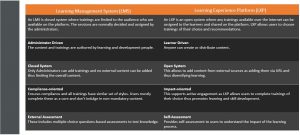At the heart of all learning initiatives in the corporate training space, there is supposed to be a business objective which needs to be achieved with the right kind of training intervention. However, most organizations fail to understand the importance of aligning learning initiatives to business goals which leads to a lot of redundant efforts. A Learning Performance Platform (LPP) builds a bridge between learning and business goals for an organization eliminating redundant processes and costs, and it’s all based on Instructional Design Theory.
Researchers across domains have unanimously voiced the need to have an application-based approach to learning or education. It is a circular process where acquiring knowledge should be directly related to the task it helps us perform. According to K. Hibbard, “Performance-based learning and assessment achieve a balanced approach by extending traditional fact-and-skill instruction”. Learning in the workplace takes place in the context of use thus the learning outcome is embedded in the performance or work practice. In the paper, Performance-Based Learning and Knowledge Management in Workplace, the authors opine –
“To drive effective performance-based learning in the workplace, learning management should consider organizational structure, policies, practices and system, that will link individual performance to organizational success.”
Performance-based approach represents a set of strategies for acquisition and application of knowledge, skills, and work habits, which are called ‘Learning Objectives’. According to Dr Robert Mager, the three things that define the learning objectives are Performance, Condition and Criteria.
How does a Learning Performance Platform bring performance-based learning to the corporate space?
Ensure Learning Management Solution is linked with the KPI model
Business Performance Management Systems or BPMS holds the performance information of the employees. These systems may vary according to the department or function. However, the learning performance platform can integrate with these systems to fetch individual performance data or the KPIs of the employees according to their job roles, departments, KRAs. This helps the learning management platform to identify the business goals or learning objectives if we take the language of theorists.
Delivering Performance Based Training and Infrastructure
Based on the information received from the BPMS, the LPP performs training need analysis for the learners. The rule-based engine identifies performance gaps and triggers training accordingly. What an Instructional Designer does to create a curriculum design is exactly what the LPP does to figure out the coaching and performance support required to achieve the KPIs set out. KPI models built into the system creates a direct path from knowledge gain, leading to business goals.
Conducting Evaluation and Providing Feedback
KPI measurement in a business happens at three different – Organization, Department, and Individual job role. For the smallest unit and action area that is the individual job role, measurement of KPI depends on the KPI Item, Rating criteria and the KPI value or proficiency level. A Learning Performance Platform enables on-job-evaluation (OJE) with flexible checklists and multiple levels of feedback models. This creates a continuous learning environment eliminating defects and shortcoming through regular
training intervention. With an in-built OJE feature, the performance-oriented learning process is completely aligned with business growth.
Commenting on the need of a Learning Performance Platform, Ankush Jagga, Business Head – Learning Technologies, G-Cube shared ‘When it comes to training initiatives becoming redundant, I feel, we were not looking at the core of the issue which is to – Integrate with Business. That’s the key to successfully define the outcome of learning programs, technology, and strategy.
At G-Cube, we have developed the Learning & Performance Platform (LPP) which integrates with your core systems – CRMs, ERPs, Quality systems etc. This allows you to set rules to trigger learning and it can integrate and work with any LMS. Now you don’t have to look for business impact data and plan training. It’s all automated and that’s business integration.’







